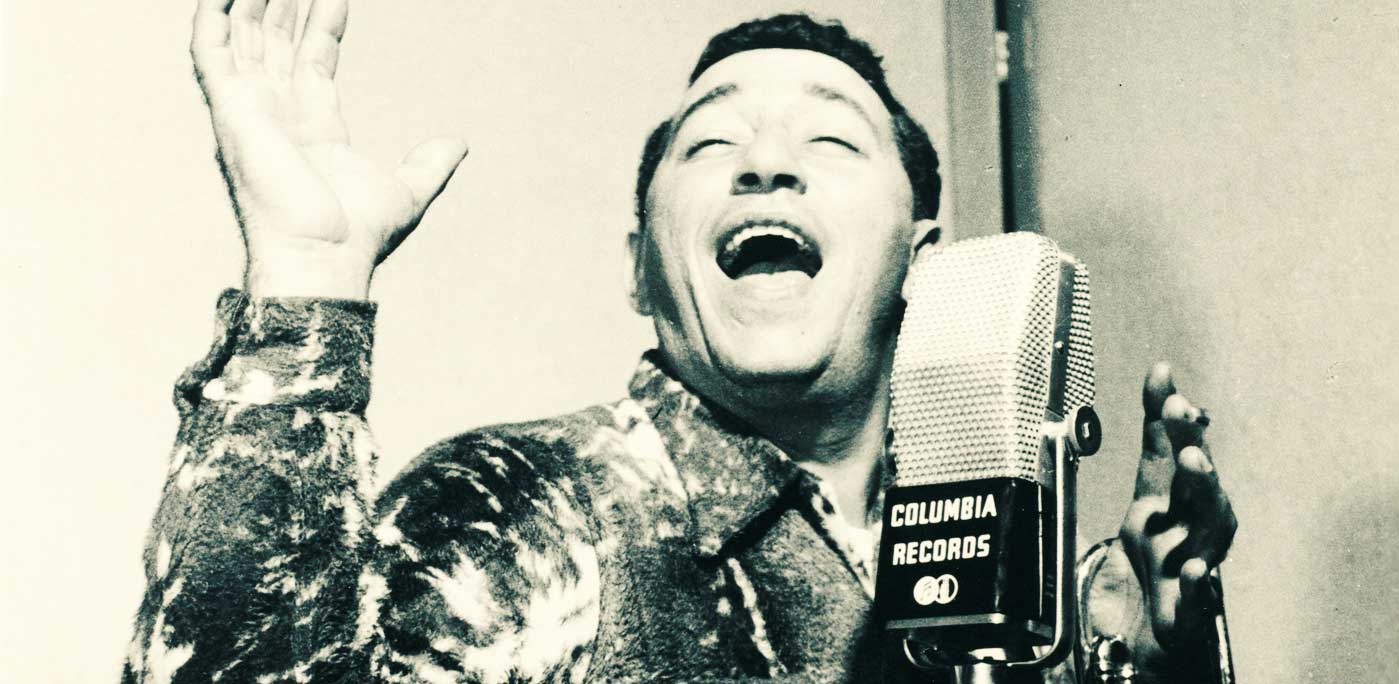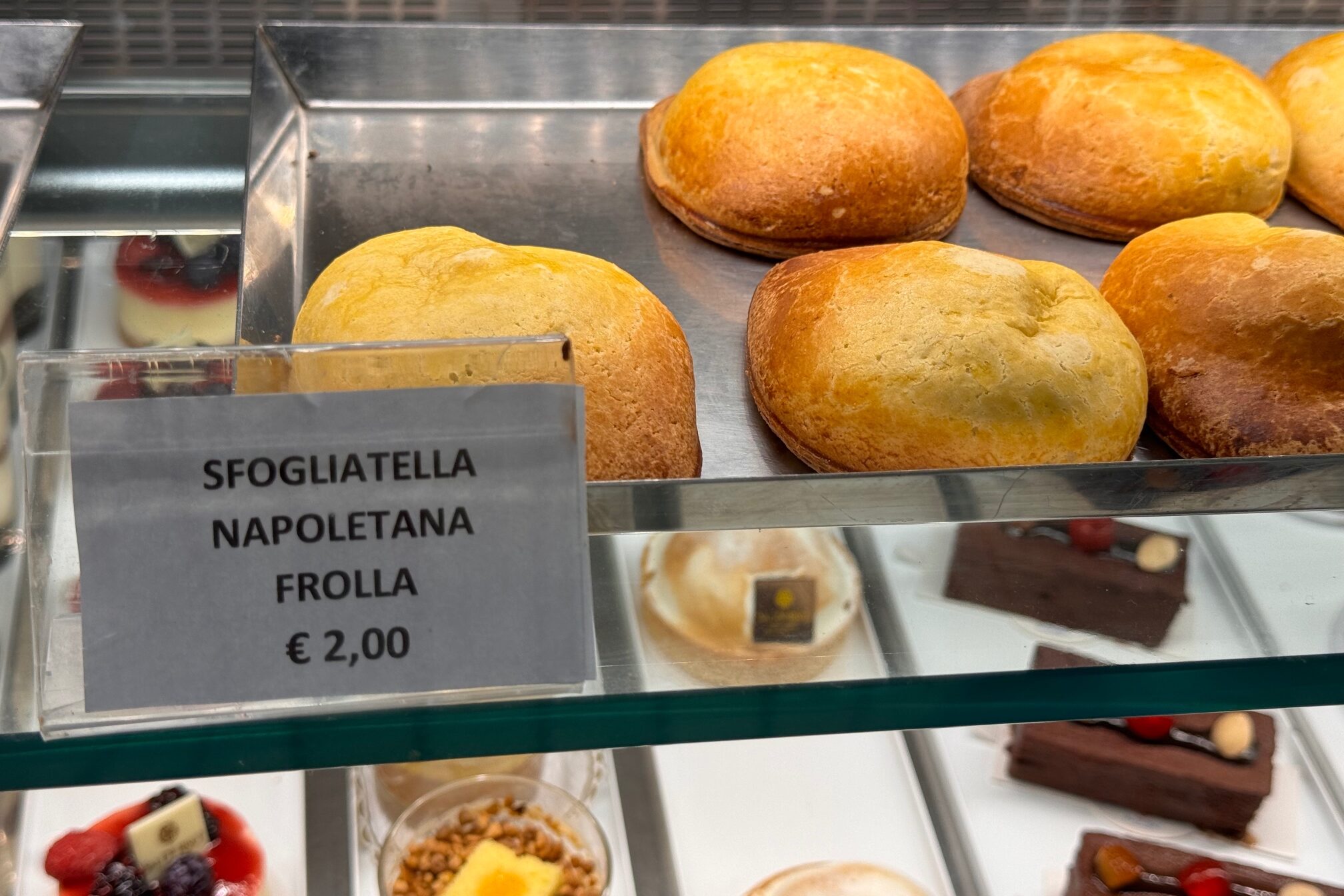During this past summer, I attended my friend’s bachelor party in New Orleans. Prior to visiting the Crescent City, I had made preliminary arrangements to mix some business with pleasure and schedule an interview with Lena Prima, daughter of Louis Prima, the irrepressible, jazz trumpeter, singer and just a gigolo New Orleanian showman from the1930s to the 1970s. We met at the Hotel Monteleone, an establishment that hosted American literary writers like Ernest Hemingway, Tennessee Williams and William Faulkner. The location is also a place where Lena had a singing residency for several years and her father, before her, had performed, in the hotel’s Skylight Room.
Now in the 21st century, Lena Prima carries on her father’s music and proud ethnic heritage, along with starting a non-profit organization Ciao Women, which recognizes Italian American women from Louisiana. Initially, Lena reminisced about her father. “I remember my father as a shining light with charisma and a happy persona that made everyone happy.” His gesticulated performances on the stages of Las Vegas and the Big Apple earned Louis the nickname The King of Swing.

Promotional portrait of Louis Prima in the 1950s. Photos courtesy of the New Orleans Jazz Museum
He sang catchy jingles using Italian accents and words in ballads during a time of considerable xenophobia. In essence, Louis became the de facto ambassador between Americans and those against Italians in WW II. His popular hits, of which critics opined that Prima played into the ethnic stereotype, like Angelina, Felicia No Capricia, Buona Sera, My Cucuzza, Topolino, Please Don’t Squeeza the Banana and Baciagaloop (Makes Love on the Stoop) were a large part of American entertainment, and his life is presently highlighted in an exhibit at the New Orleans Jazz Museum. “Louis Prima,” as music curator David Kunian for the museum explained, “deserves to be considered with the icons of New Orleans music. He is up there with Armstrong, Bechet, Toussaint, Domino, Dr. John, and Lil Wayne.”
Louis Prima and his wife Gia Maione had two children, Lena was born in (Las Vegas) 1963 and Louis Prima Jr. in 1965. In 1963, Gia became the entertainer’s fifth wife and replaced another one of Louis’ ex-wives and most popular band mates, Heely Smith. Gia joined Prima, Sam Butera and the Witnesses for several years until Louis passed away in 1978.

Lena Prima, daughter of legendary Italian American musician Louis (©: Lena Prima)
Lena was fourteen when her father died. His passing prompted her to carry on his music and create her own singing career. At an early age, she followed her parents’ musical path. “I remember the first night I performed with my father as if it were yesterday. It was in 1969 at the Sands and I sang the only song I knew at five/six years old, Santa Claus is coming to Town. From then on,” said Lena gleefully, “I loved to sing.”
The singer continues to entertain, as she recently released, in early 2019, Prima la Famiglia, that debuted at #10 on the Billboard Jazz Chart. “The songs are a representation of what Italian Americans grew up with back in the 40s, and that carried on throughout generations. They played this music in their family homes, at Sunday dinners, weddings, and they are just beloved songs,” explained Lena.
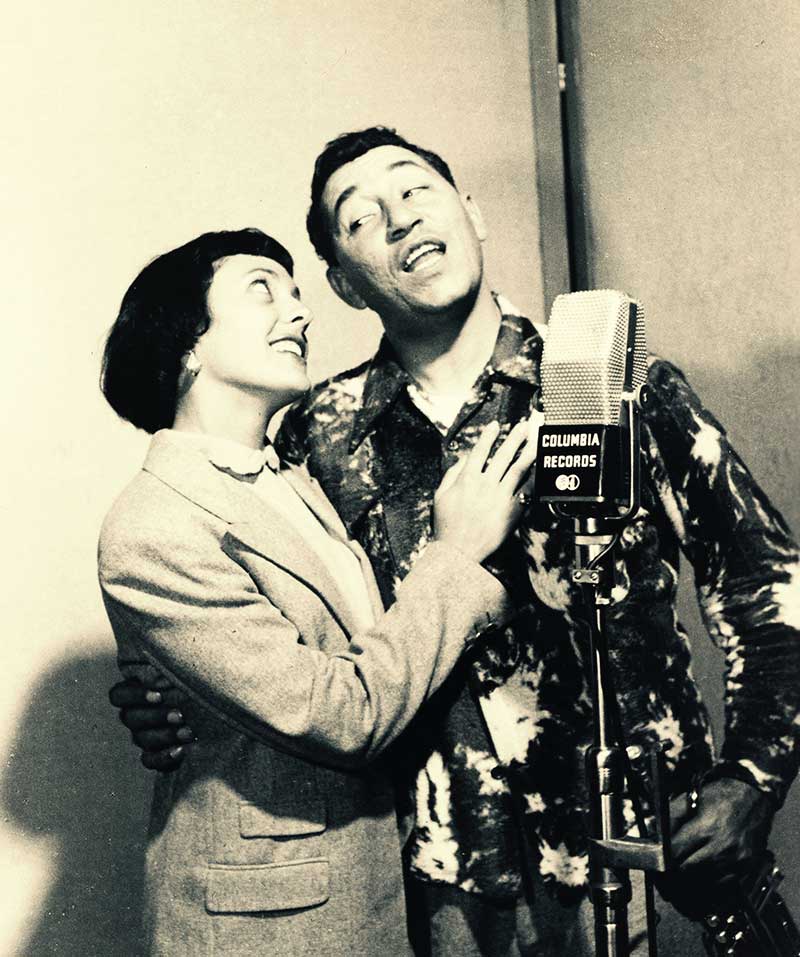
Louis Prima singing with Keely Smith in 1951. Photos courtesy of the New Orleans Jazz Museum
For many Italians and Sicilians, Prima provided a combination of Dixieland and swing. “Louis Prima was my childhood hero growing up in New Orleans,” said Rocco Cardona, a taxi driver and a lifelong resident of the Big Easy. “We loved the guy because he was Sicilian like many of us,” Rocco said. Similar to Rocco and his family, Louis Prima’s relatives, like most Sicilians in New Orleans, emigrated from the island in the late 19th century to find work in the Louisiana fields.
Several thousand Sicilian immigrants disembarked along the Mississippi and reached New Orleans. Many lived in the French Quarter and adjoining districts, and by 1910, there were more than 23,000 Italians living in Louisiana. At one point, the French Quarter was sometimes referred to as Little Palermo. Louis Prima, the second child of Anthony Prima and Angelina Caravella, was born on St. Peter Street in the Tremé neighborhood of the Big Easy. Louis’ older brother Leon, a musician, inspired him to play the trumpet as did Louis Satchmo Armstrong. Louis was lucky enough to hear and learn from many of his hometown musicians, and that was the secret to his success.
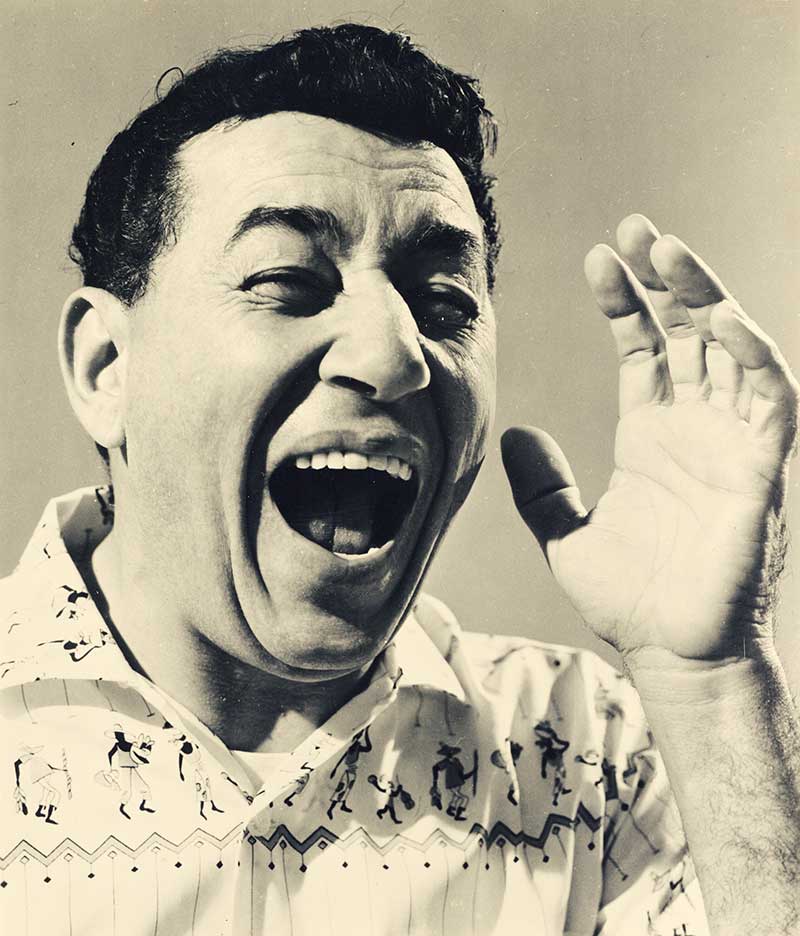
Louis Prima in a promotional picture (1957) (Ⓒ: Hogan Jazz Archive) Courtesy of New Orleans Jazz Museum
Prima’s hepcat jive and musical improvisation impressed many in the jazz world, especially because of his Italian American upbringing in New Orleans. The city, as it was typical of most urban centers, was defined by various cultures and allowed Prima to interact with all races and nationalities. “I remember hearing a BBC interview of my dad in the early 1970s where he described growing up in a neighborhood with no fences in between houses and the streets were made of mud,” said Lena.
One of the songs on Prima la Famiglia, which Lena sings, is Darktown Strutters Ball, a direct New Orleans sound that her father first sang in Sicilian and Yiddish. “He would sometimes end his shows singing C’è la Luna Mezz’o Mare and suddenly cross over to Hava Naglia, and the audiences would go into a frenzy,” explained Lena. As Lena has grown older, it has gotten closer to her Italo American roots. “My father was very proud of his city and culture and he would always tell me ‘be proud of your name, Prima means first.’”
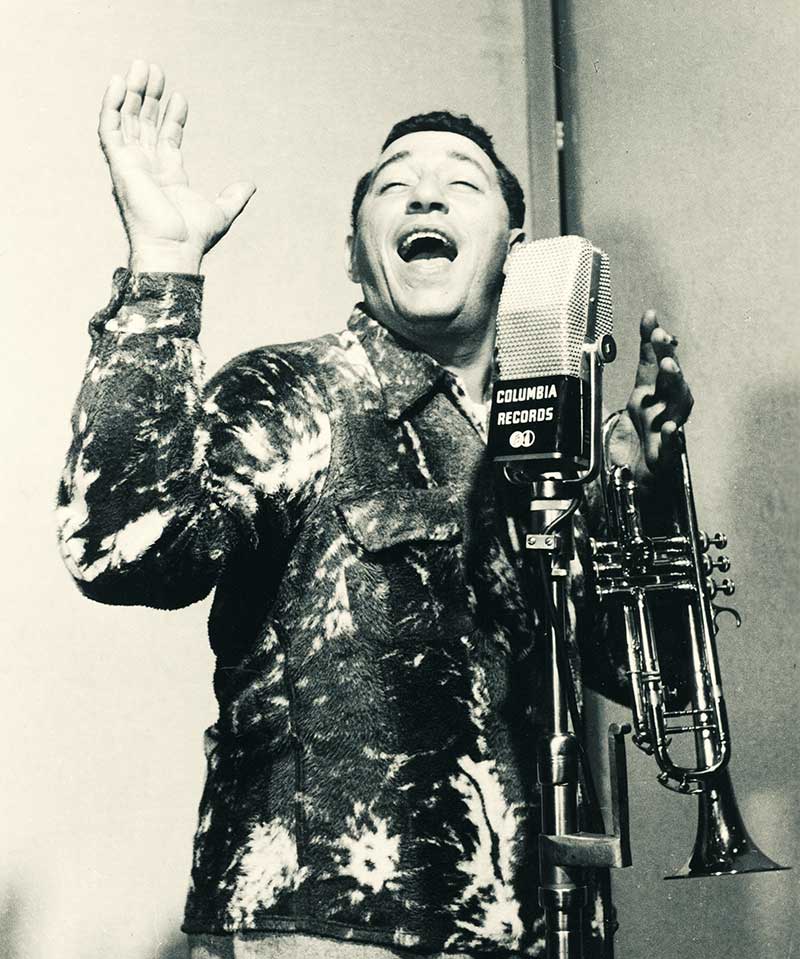
Columbia Records promotional photograph Frank Driggs, 1951. Courtesy of New Orleans Jazz Museum
In 2011, Lena and her husband decided to move from Las Vegas to her father’s hometown. Determined to reconnect with her Louisiana heritage, Lena started a nonprofit organization that recognizes Italian American women/men from the state. “I want to work on fun ways to educate others about the rich Italian heritage in Louisiana and perpetuate the Italian American legacy and traditions,” said the singer/songwriter, who was motivated to start CIAO Women by another Italo American.
“Actually I was inspired to start CIAO Women because of Charles Marsala who honored me a few years ago during Italian Republic Day,” Lena said. Charles, a Louisiana native, is very active in preserving and informing visitors about Italian history in the state. He is the host of AWE News that celebrates local heroes in their communities. He launched a tour app for Little Palermo and was recently elected President of Italian American East Organization. “Lena is amazing for New Orleans. She performs many of her father’s hits throughout the state and is truly an inspiration,” declared Charles.
Just like Charles Marsala, Lena is committed to honoring the strong Italian traditions in New Orleans and, like her father, to bringing joy through the wonderful sounds of jazz.
Quest’estate ho partecipato all’addio al celibato di un mio amico a New Orleans. Prima di visitare Crescent City, ho preso accordi preliminari per mescolare un po’ di lavoro con il piacere e ho programmato un’intervista con Lena Prima, figlia di Louis Prima, l’incontenibile trombettista jazz, cantante e showman di Just a Gigolo di New Orlean, dagli anni Trenta agli anni Settanta.
Ci siamo incontrati all’Hotel Monteleone, un locale che ha ospitato letterati americani come Ernest Hemingway, Tennessee Williams e William Faulkner. La location è anche il luogo in cui Lena ha avuto una residenza canora per diversi anni e suo padre, prima di lei, si esibiva nella Skylight Room dell’hotel.
Ora, nel XXI secolo, Lena Prima porta avanti la musica del padre e l’orgogliosa eredità etnica, insieme alla creazione di un’organizzazione no-profit, Ciao Women, che celebra le donne italoamericane della Louisiana. Inizialmente, Lena ha ricordato suo padre. “Ricordo mio padre come una luce splendente di carisma e una persona felice che ha reso tutti felici”. Le sue gesticolate esibizioni sui palchi di Las Vegas e della Grande Mela hanno fatto guadagnare a Louis il soprannome di The King of Swing.
Cantava accattivanti jingle con accenti e parole italiane nelle ballate durante un periodo di grande xenofobia. In sostanza, Louis divenne di fatto l’ambasciatore tra gli americani e quelli che erano contro gli italiani nella seconda guerra mondiale. I suoi popolari successi, in cui la critica ha sostenuto che Prima abbia giocato sullo stereotipo etnico, come Angelina, Felicia No Capricia, Buona Sera, My Cucuzza, Topolino, Please Don’t Squeeza the Banana e Baciagaloop (Makes Love on the Stoop) sono stati una parte importante dello spettacolo americano, e la sua vita è attualmente messa in evidenza in una mostra al New Orleans Jazz Museum. “Louis Prima”, come ha spiegato il curatore musicale del museo David Kunian “merita di essere considerato fra le icone della musica di New Orleans. È lassù con Armstrong, Bechet, Toussaint, Domino, Dr. John e Lil Wayne”.
Louis Prima e sua moglie Gia Maione hanno avuto due figli, Lena è nata a Las Vegas nel 1963 e Louis Prima Jr. nel 1965. Nel 1963, Gia divenne la quinta moglie dell’intrattenitore e sostituì un’altra delle ex-mogli di Louis e una dei compagni di gruppo più popolari, Heely Smith. Gia si unì a Prima, Sam Butera e ai Witnesses per diversi anni fino alla morte di Louis nel 1978.
Lena aveva quattordici anni quando suo padre morì. La sua scomparsa l’ha spinta a portare avanti la sua musica e a creare la sua carriera di cantante. In tenera età, ha seguito il percorso musicale dei genitori. “Ricordo la prima sera in cui mi esibii con mio padre come se fosse ieri. Era il 1969 al Sands e ho cantato l’unica canzone che conoscevo a cinque/sei anni, Santa Claus is coming to Town (Babbo Natale arriva in città). Da quel momento in poi – ha detto Lena allegramente – mi è piaciuto cantare”.
La cantante continua ad esibirsi e ha recentemente pubblicato, all’inizio del 2019, Prima la Famiglia, che ha debuttato al numero 10 della Billboard Jazz Chart. “Le canzoni sono una rappresentazione di quello con cui gli italoamericani sono cresciuti negli anni ’40, e che è stato portato avanti di generazione in generazione. Quella musica ha suonato nelle loro case di famiglia, durante le cene domenicali, i matrimoni, e sono solo canzoni molto amate”, ha spiegato Lena.
Per molti italiani e siciliani, Prima ha fornito una combinazione di Dixieland e Swing. “Louis Prima era il mio eroe d’infanzia che cresceva a New Orleans”, ha detto Rocco Cardona, tassista che vive da sempre nel Big Easy. “Lo amavamo perché era siciliano come molti di noi”, ha detto Rocco. Come Rocco e la sua famiglia, i parenti di Louis Prima, come la maggior parte dei siciliani di New Orleans, emigrarono dall’isola alla fine del XIX secolo per trovare lavoro nei campi della Louisiana.
Diverse migliaia di siciliani sbarcarono lungo il Mississippi e raggiunsero New Orleans. Molti vivevano nel Quartiere Francese e nei quartieri adiacenti, e nel 1910 c’erano più di 23.000 italiani che vivevano in Louisiana. A un certo punto, il Quartiere Francese venne indicato come Little Palermo.
Louis Prima, secondogenito di Anthony Prima e Angelina Caravella, nacque in St. Peter Street, nel quartiere Tremé della Big Easy. Il fratello maggiore di Louis, Leon, musicista, lo ispirò a suonare la tromba, così come Louis Satchmo Armstrong. Louis ebbe la fortuna di ascoltare e imparare da molti dei musicisti della sua città natale, e questo fu il segreto del suo successo.
L’hepcat jive di Prima e l’improvvisazione musicale hanno impressionato molti nel mondo del jazz, soprattutto per la sua educazione italoamericana a New Orleans. La città, come era tipico della maggior parte dei centri urbani, è stata definita da diverse culture e questo ha permesso a Prima di interagire con tutte le etnie e le nazionalità. “Ricordo di aver ascoltato un’intervista della BBC di mio padre all’inizio degli anni ’70 in cui raccontava di essere cresciuto in un quartiere senza recinzioni tra le case e dove le strade erano fatte di fango”, ha detto Lena.
Una delle canzoni di Prima la Famiglia, cantata da Lena, è Darktown Strutters Ball, che ha sonorità chiaramente di New Orleans, che suo padre ha cantato per la prima volta in siciliano e yiddish. “A volte terminava i suoi spettacoli cantando C’è la Luna Mezz’o Mare, che poi improvvisamente si incrociava con Hava Naglia, e il pubblico andava in delirio”, spiega Lena. Con l’avanzare dell’età, Lena si è avvicinata alle sue radici italoamericane. Mio padre era molto orgoglioso della sua città e della sua cultura e mi diceva sempre “sii orgogliosa del tuo nome, Prima significa prima di tutto”.
Nel 2011, Lena e suo marito hanno deciso di trasferirsi da Las Vegas alla città natale del padre. Determinata a riconnettersi con le sue radici in Louisiana, Lena ha fondato un’organizzazione no-profit che celebra le donne e gli uomini italoamericani dello stato. “Voglio lavorare a modi piacevoli di educare gli altri sulla ricca eredità italiana della Louisiana e perpetuare l’eredità e le tradizioni italoamericane”, ha detto la cantante e cantautrice, che è stata motivata a fondare CIAO Women da un altro italoamericano.
“In realtà sono stata ispirata a fondare CIAO Women da Charles Marsala che mi ha reso omaggio qualche anno fa durante la Festa della Repubblica Italiana”, ha detto Lena. Charles, originario della Louisiana, è molto attivo nel preservare e informare i visitatori sulla storia italiana nello Stato. Sostiene AWE News che celebra gli eroi locali nelle loro comunità. Ha lanciato un’app turistica per Little Palermo ed è stato recentemente eletto presidente dell’Italian American East Organization. “Lena è incredibile per New Orleans. Si esibisce in molti dei successi di suo padre in tutto lo Stato ed è veramente un’ispirazione”, ha dichiarato Charles.
Proprio come Charles Marsala, Lena è impegnata a onorare le forti tradizioni italiane a New Orleans e, come suo padre, a portare gioia attraverso i meravigliosi suoni del jazz.





